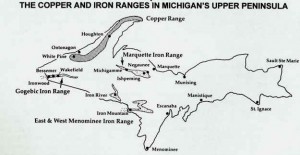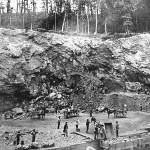
The Marquette iron range helped create one of the largest communities in Michigan’s Upper Peninsula. The roots of a large percentage of the Upper Peninsula population connect some way with the range. What many people don’t understand is how the range had such a large impact on the outcomes of wars, especially World War II. However, the most misunderstood aspect about the Marquette iron range is the working conditions and the life of a miner during those booming times. Some first-hand experiences will recount of the hard work each miner struggled through, which in the end played a key role in the Allies’ victory during World War II.
The Marquette Iron Range
The first iron rich area to be mined near Lake Superior was the Marquette iron range. The iron range was discovered by William A. Burt by discovering iron ore outcroppings south of Teal Lake, which is located just west of Marquette. The Marquette iron range is known as the Negaunee Iron Formation by geologists. The first mine was erected under the Jackson Mining Company in 1847. This mine was called the Jackson mine after the company which formed it. After the Jackson Mining Company began to grow more and more companies formed to seek profit from the mining industry. The Negaunee iron formation has been consistently mined from 1847 till current day. The mine industry flourished and fell, however for the mines to be continually mined for over 150 years is a remarkable feet.

World War II
Ronn Enrie began working at the Cleveland Cliffs Iron Company on June 21, 1943. This was right in the peak of the United States role in World War II. The United States home front fueled the Allied efforts in World War II. The war was a two sided war; there was the Atlantic Ocean and the Pacific Ocean. In the Atlantic Ocean the German U-boats were sinking thousands of tons of war aid to the allies being shipped on cargo vessels along with destroying virtually every escort ship the allies were using. The only way to safely send war aid to the allies was to escort the cargo ships with destroyers. This meant that the United States would need to increase the number of Navy destroyers it had after the destruction of the fleet at Pearl Harbor. Therefore in the Pacific Ocean aircraft carriers were growing more and more important in the strategic island hopping strategy of the United States. For the island hopping strategy to become effective the America would need to increase production to extreme levels. With the demand of these new military goods rising through the roof and the destruction of the European Allied production facilities, the weight of producing military equipment landed directly on the United States’ shoulders. In the journal, Myth vs. Reality: The Question of Mass Production in WWII¸ graphs show America’s total domination of total output of war equipment. The American industry at least doubled the production of all other countries in the war in every category. During the year 1940 the United States production was equivalent to that of the U.S.S.R., Japan, United Kingdom and Germany. However, by 1943 the United States aircraft production was nearly triple of what the Japanese and Germans were producing. Along with total aircraft being made the number of aircraft engines produced also showed the same trend. Total aircraft weight also showed the same trend. In 1940 the United States was not fully in the war but by 1943 the United States was fully in the war, helping in both the Atlantic and the Pacific. The huge gap between The United States production levels and those of Japan, Soviet Union, the United Kingdom and Germany can be explained with simple explanations. First off, World War II had no bombings that took place on the American homeland. On the contrary the four other countries were in the midst of the bombings, Great Britain was nearly completely destroyed by Germany. in turn the Allies were bombing the German and Japan factories destroying their ability to produce war equipment. This destruction of Allied and Axis factories forced America to pick up the slack and produce enough equipment to overcome the axis powers.
Marquette Range’s Community
The Marquette iron range played a key role the formation of one the largest communities in all of the Upper Peninsula. The Marquette iron range employed most every working male in Marquette and Negaunee. In, Fifty-two Steps Underground: An Autobiography of a Miner, Ronn Ernie the author describes how tight knit the community of Negaunee was due to the mine. Let alone in Ronn’s family there were several mine workers which included; his father, grandfather and many uncles. He later goes on to say, “The mines attracted men of many nationalities.” The author lived on Ann Street, which of the thirty one houses on Ann Street only one was not owned by the mining companies. The Upper Peninsula is unique both geographically and in its diversity. This being said, for men of many different nationalities to migrate to Marquette, which has an average of 120 inches of snow per year, helps us understand how thriving the mining business was. The mining field created a need for more and more miners.
This explosion was created with the fuel of industrial revolution. The industrial revolution changed the world; America was now able to mass produce products thanks to the inventions of machines and the assembly line. Along with the industrial revolution the end of the Civil War transformed military tactics for the whole world. Iron was now critical to the manufacturing of technology like iron clad warships, submarines and artillery. This increase in demand for iron only fueled the fire of the mining industry.
Ronn Ernie described his first day of work in Chapter 4 of his autobiography. June 21, 1943 was Ronn’s first day underground at Cleveland Cliffs Iron Company. Just eight days after Ronn graduated from Negaunee High School he was ready to begin his career. His shift started at 12:00 P.M. and ended at 8:00 A.M. Over the eight hour shift he made, “nearly $4.50”. Four dollars and fifty cents translated to today is roughly sixty three dollars. This is almost exactly this same as a minimum wage worker would make in 2015. Except one this is a huge difference. Minimum wage jobs in 2015 are usually not manual labor. The jobs that pay minimum wage do not have the actually possibility that every time you go to work you could die due to the dangerous conditions. However, due to the increase of demand of iron the mines were churning twenty four hours every day. Not only did the workers work eight hours of physically tasking labor a day, the miners worked under some terrible conditions. Ronn Ernie had several sections in chapter five which enlighten the reader on how bad the conditions were. One section was called, Big Rats. The rats in the Negaunee Mine were menacing, they would go as far as chewing holes in the miner’s coats in order to reach their lunches. Rats may seem like a big problem however, the worst problem of working in the mine was the threat of cave-ins and other accidents. The cave-ins became more frequent as the demand for iron pushed the underground mines grew larger and more dangerous. In Fifty-Two Steps Underground many stories of cave-ins and other accidents are described some of the accidents weren’t deadly, but many others were deadly. Not only were the cave-ins deadly for the miners below they hurt the community of Negaunee and killed several Negaunee community members.
The Mines Environmental Effect
World War II pushed the mines to the brink. World War II brought the demand of the iron to an all time high. This skyrocketing of iron not only brought the booming economy to the Marquette and Negaunee area but when the iron left it took the booming economy and left behind the environmental destruction. As the demand for the iron in the Marquette range increased the size of the mines increased to insure the ability to match the demand. However, in mining accidents happen, and according to An Environmental History of the 19th Century Marquette Iron Range both surface and underground mining was occurring due to the vast amount of iron ore both above and below the surface. Having both above and below ground mines made it possible to mine the soft iron above the ground along with the hard iron below the surface. This combination of surface deterioration along with growing mines below the surface is a deadly combination. In Fifty-Two Steps Underground chapter 8 the author talks about a sudden initial cave in. “A sudden and unexpected initial cave-in came at the end of Boyer Avenue on the western end of Ann Street. I don’t believe that the mine owners ever expected such an unexpected cave-in any more than the people. No one could have predicted the extent of this rather small area growing as wide and as deep as it already has. After the Boyer Avenue cave-in, the old mined-out areas underground have silently and steadily claimed more and more of the surface above.” This slow process of cave-ins was surprising and detrimental to the Negaunee community. Not only were the cave-ins destroying much of Negaunee’s original territories, three young boys died. One young boy, Dale LaFreniere, fell into a shaft just a few feet south of Iron Street. “Not very long after the tragic loss of this little boy, two 11-year-old boys lost their lives while sliding down the bank of the cave-in between Negaunee and Maas Mines.” These accidents deflated the community and helped push for the safety of the mining areas to increase.
Conclusion
The Marquette iron range played an instrumental role in the development of one of the large population in the Upper Peninsula. The demand for Michigan’s Upper Peninsula rich deposits of iron rose through the roof with the beginning of World War II. The workers in the mines, much like Ronn Arnie were pressed to the limit in poor working conditions which ultimately made the environment pay the cost. World War II demanded much from the United States resource wise and pressed the Marquette Mine to full potential.
Primary sources
- Ronn, Ernie. Fifty-two Steps Underground: An Autobiography of a Miner. Marquette, Mich.: Center for Upper Peninsula Studies, Northern Michigan U, 2000.
- Fogel, Robert W., and Stanley L. Engerman. “A Model for the Explanation of Industrial Expansion during the Nineteenth Century: With an Application to the American Iron Industry.” Journal of Political Economy J POLIT ECON3 (1969): 306-28.
- Ottke, Doug. “An Environmetal History of the 19th Century Marquette Iron Range.” 1 Dec. 1999. 10 Nov. 2015.
- Goodwin, Doris. “The Way We Won: America’s Economic Breakthrough During World War II.” The American Prospect. 1992. 16 Nov. 2015.
Secondary Sources
- Paxton, John. “Myth vs. Reality: The Question of Mass Production in WWII.” Economics and Business Journal; Inquiries and Perspectives1 (2008): 91-104. Myth vs. Reality
- “Iron;Steel Industry.” Dictionary of American History. 2003, John Cannon. “Iron and Steel Industry.” Encyclopedia.com. HighBeam Research, 2003. Iron Industry
- “You Are Here: Michigan Historical Center Museums Iron Industry Museum.” Michigan Historical Center. Michigan Iron Museum
- “Marquette Iron Range.” Marquette Iron Range. MSU on Marquette Iron Range
- “What’s in a Name?” About the North Jackson Company. North Jackson Company.
For Further Reading
Fifty-two Steps Underground: An Autobiography of a Miner, by Ernie Ronn.
